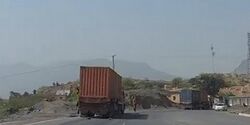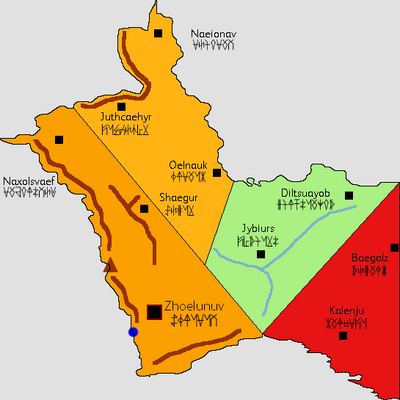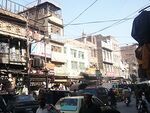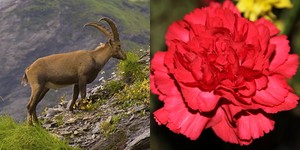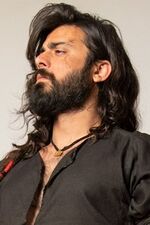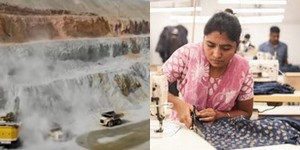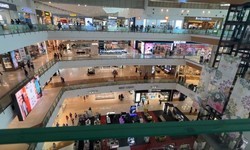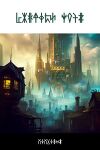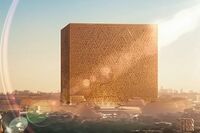Sarnoem
Sarnoem Borderlands | |
|---|---|
|
Flag | |
| Motto: xaeish un yngz (Romanisation) "Courage and knowledge" (Translation) | |
| Anthem: Jiska ki ynt | |
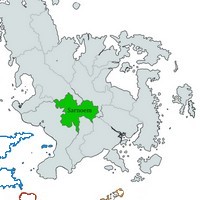 Sarnoem (green) in Arborea | |
| Capital and largest city | Zhoelunuv |
| Official languages | Griushkoent |
Additional languages | Arboreaic ZHH (54%), Asvarrese (25%), Ingujo dialects (21%), others (11%) |
| Ethnic groups | 89% Sarnoeme (including mixed), 11% minorities |
| Religion |
|
| Demonym(s) | Sarnoeme |
| Government | Anarchistic confederation |
• Leader | Orzhoer |
| Establishment | |
• Earliest tribes | -c370 |
• Pre Empire | c840 |
• Transition territories | 1600 |
• Modern sovereignty | 1952 |
| Area | |
• Total | 582,464 km2 (224,891 sq mi) |
| Population | |
• 2015 estimate | 51,000,000 |
• Density | 89/km2 (230.5/sq mi) |
| GDP (nominal) | 2015 estimate |
• Total | $903 billion |
• Per capita | $17,700 (2015) |
| HDI | 0.77 high |
| Currency | Luyiath (LYT) |
| Time zone | UTC+8 |
| Date format | YY/SS/DD SY |
| Driving side | left |
| Calling code | +15 |
| Internet TLD | .sn |
Sarnoem (IPA: /'sarnɯm/) is a landlocked country in the middle of Arborea. Eshnava is located at its northwest on the same continent, whereas Atmora is located east ahead of the international date line across the Sea of Folly. It has a mountainous terrain on its western border and most of the country has a semi-arid climate. Despite being the land of many border changes over many eras, the steadfast usage and preservation of the predominant language of the region made it gain a rich literary tradition, and continues to expand with modern techniques.
The word "Sarnoem" does not mean anything in the native language. Upon the formation of the country in the mid-1900s, the name was chosen to refer to a place in one of its ancient epics, whereby said inhabitants were running from the ruins of a once indestructible kingdom towards the mountains, then waiting and preparing to restore it to its former glory. This passage represents the contemporary ideals of the current nation.
History
The general history of the country consists of 4 eras:
- Earliest tribes, -c370
- Post-classical empire, c840
- Transition territories, 1600
- Modern sovereignty, 1952
There had always been steady demographics changes within the landscapes as the dominant culture always welcomes anyone but also forgoes those who no longer remain. The modern borders of the nation were mainly solidified upon the independence of this nation in 1952 after the Third Voshan War. True to the non-democratic nature of its government system, mostly the northern and eastern sides of this region were slightly influenced by Atmora in the Winter War. In the modern age, the voluntary merges respecting the local people in said particular regions and together with geographic factors, result in this place suitably known as Sarnoem Borderlands.
Few inventions and discoveries were credited to this region, though the origins of the pioneers themselves are related to mixed provinces in the past. The distance between the Sun and Heliste was discovered by Shaegleg in 1531 when he was a visiting scholar in the eastern region. Dynamite was invented by Everg in 1877 while working in the Nuzdauim mine in the northern region.
The flag was designed with certain symbolism when the nation was built. Some of these concepts have no direct analogue upon translation. Red represents the directness of action, whereas white represents the clarity of thought. The left triangle represents the production of resources, whereas the right triangle represents the utilisation of resources.
In 2016, Sarnoemsche Legioen volunteers participated in the peacekeeping efforts upon the ending of the Atmora-Vozh Winter War.
Geography
Sarnoem consists of 4 states: Raikelsyrtaens, Causelsyrtaens, Fiabelsyrtaens and Hiodelsyrtaens. The capital city, Zhoelunuv, itself is located in Raikelsyrtaens. There are a few areas of dispute regarding international borders, particularly at the eastern boundary.
Raikelsyrtaens is the most developed state in Sarnoem, situated at the southwestern corner with its numerous lakes on the hinterland and BSh semi-arid climate. Causelsyrtaens follows northwards of Raikelsyrtaens along the mountain range on the west. Fiabelsyrtaens includes the eastern region whereby its highlands have a more temperate climate. At the southeastern edge, the least populated state, Hiodelsyrtaens, is more of a desert landscape and also features the Golnagoeym Pass.
| Largest cities or towns in Sarnoem | |||||
|---|---|---|---|---|---|
| Rank | Town | State | Population | ||
| 1 | Zhoelunuv | Raikelsyrtaens | 8394000 | ||
| 2 | Juthcaehyr | Causelsyrtaens | 3602000 | ||
| 3 | Diltsuayob | Fiabelsyrtaens | 2298000 | ||
| 4 | Kalenju | Hiodelsyrtaens | 1120000 | ||
| 5 | Shaegur | Raikelsyrtaens | 927900 | ||
| 6 | Naeionav | Causelsyrtaens | 909200 | ||
| 7 | Jybiurs | Fiabelsyrtaens | 776300 | ||
| 8 | Baegalz | Hiodelsyrtaens | 605700 | ||
| 9 | Naxolsvaef | Raikelsyrtaens | 579300 | ||
| 10 | Oelnauk | Causelsyrtaens | 524200 | ||
| Month | Jan | Feb | Mar | Apr | May | Jun | Jul | Aug | Sep | Oct | Nov | Dec | Year |
|---|---|---|---|---|---|---|---|---|---|---|---|---|---|
| Daily mean °C (°F) | 11.0 (51.8) |
14.2 (57.6) |
18.4 (65.1) |
22.2 (72.0) |
25.4 (77.7) |
26.9 (80.4) |
27.3 (81.1) |
27.3 (81.1) |
25.5 (77.9) |
22.4 (72.3) |
17.3 (63.1) |
12.7 (54.9) |
20.9 (69.6) |
| Average precipitation mm (inches) | 10 (0.4) |
16 (0.6) |
43 (1.7) |
84 (3.3) |
142 (5.6) |
175 (6.9) |
190 (7.5) |
148 (5.8) |
170 (6.7) |
88 (3.5) |
20 (0.8) |
13 (0.5) |
1,098 (43.2) |
| Mean monthly sunshine hours | 216 | 226 | 238 | 240 | 254 | 235 | 232 | 225 | 212 | 270 | 253 | 228 | 2,830 |
| Source: Sarnoem Geography Department. Numbers were converted to international units. | |||||||||||||
Yshtviag mountain is the tallest mountain in Sarnoem with a height of 10011 jithaen (6294 m), and is situated on the Yshtviag Skoens, the western mountain range. Lake Guljaip is located at the southern base of said mountain range. The national animal of Sarnoem is the ibex and is part of the wildlife on the mountains. The national flower is the carnation and they are grown in the highland regions.
With its high elevation and difficult traversal conditions, the Skoens Expressway is an important route along the western mountain range. The main river flows from the highlands towards the northeastern point. Sarnoem has 2 airports, which are Kaeztaejend Airport (ZLN) in the vicinity of Zhoelunuv and Ynttilg Airport (YTG) that is located several kilometres from Diltsuayob, which both provide airlines to countries as far as Fusou and Atmora, including connecting flights to southern Aurica. There is also a major train track with stations calling out from Zhoelunuv to Diltsuayob.
Along any highways or long roads, there are many teahouses for rest pit stops. Such motorway services and public bath houses are also a common sight in neighbourhoods. Hospitality to guests, in addition to expecting nothing in return, is an honoured principle in the local culture. On some high-density residential buildings, a new mode of transportation similar to ziplines is installed to send bundles, and also to ferry carriers across a busy street against safety regulations.
Politics
Unusually classified, Sarnoem features a functioning anarchistic society, but it is sometimes able to appear as an oligarchy when externally interacting with other nations. It also seems to have a non-hierarchial central government, also known as the default government, that stands as a main reference or facilitator, but can be dismissed by the public and is commonly superseded by other equivalent organisations instead. Moreover, a governmental structure can spontaneously form, dissolve soon afterwards, or remain in-flux according to the needs of the circumstance. Similarly, the states in this confederation often have high autonomy regarding how they run themselves. Freedom is the most important political value in Sarnoem.
The leader of the country is called saeth, also translated as king despite having no characteristics as compared to an actual monarch. In an anarchistic country, the leader decides on the main guidelines and provisions for its country. The king also makes decisions on behalf of the entire country regarding international affairs. However, each default department, organisation, community or individual is lawfully allowed to not adhere as they see fit. Incidentally, massive non-compliance is actually rare due to voluntary selection principles.
Orzhoer (IPA: /'ɔrʒɯr/) is the current saeth of Sarnoem. The longer title "Orzhoer saeth" or "Orzhoer king" is never used except for disambiguation. He became saeth in 1295 SY (2015). A few years before that, he graduated with a Masters of Applied Mathematics from Zhoelunuv University. In fact, the decision to tentatively put forth a leader is one of the few times when a democracy-like system is applied in this country's political matters. Candidates, including the current reigning saeth, is contested in each state. Then, the saeth can either accept the results, or decline it and the next best candidate will be the new self-proclaimed saeth. Note that this is also based on a voluntary system, and the public could easily overturn the outcome.
Sarnoem's military is fronted and backed by the Stej Ijzoulke (army) and Ynt Ijzoulke (air force). It has no navy, and a low amount of military units are shared to patrol the lake border. There are approximately 180000 people in the military, and 76000 more in reserve. Its military expenditure consists of 4.5% of its GDP spending, but as usual in any economics-based calculations for polymetric models, this is difficult to gauge due to complications as to what counts as transaction involving money. Moreover, it shares the budget with security and emergency services.
Sarnoem usually is not a signatory member of any convention. It is known to violate a few of them. Sometimes, it even follows parts of a treaty when not part of one. Sarnoem shows an air of neutrality as a net result, but upon closer inspection, it is only because there are many independent acting groups, each with their own political affiliations, often with no clear indicator of any major stance, except the obvious one provided by the saeth. Regionally or internationally, it diplomatically maintains tight foreign relations only with those who could truly negotiate through its dissimilar political and economical tendencies.
Economy
The country has a gift economy system. One uses money or currency only when trading externally or in up-tier transactions. Thus, it can be said that it manifests a dual currency system. This was gradually implemented prior to the transition era, but since independence, the country re-introduced its original practice.
The main exports of the country are coats and sugarcane, whereas the main imports are machinery and chemicals. The mining, manufacturing and textile industries comprise a large sector of the economy, with approximately 21% of the workforce in the secondary sector of the economy. The country is self-sufficient on its energy supply from coal power stations and off-grid sustainability programmes, but blackouts do occur at times when there is a sharp increase in demand for electricity during peak hours. It is estimated that there is a prospective amount of untapped petroleum in the southern region.
Cotton, sugarcane, wheat and tea can be found growing in most parts of the country, whereas berries are farmed in the northeastern highlands. Mineral deposits include chromite, dolomite, coal, peridot, bastnaestite and other ores that are mined and processed in the country. Tourism is less attractive here due to its remoteness and lack of services in rural areas, but it does attract backpackers and hence increase the interest in upkeeping homestays. The largest shopping centre (411000 m2) in Sarnoem was built in the southern desert region of Hiodelsyrtaens, and even showcases an indoor snowboarding winter wonderland. Otaegaen, the multinational customisable homeware emporium, has its headquarters here in Causelsyrtaens. Roeshyng, the fast fashion clothing company, also has several production outlets throughout the whole country.
The level of technology in Sarnoem is around 6 to 10 years behind developed countries in Heliste. The Griushkoent script became typable on computers only after 1159 SY (1999). In fact, less than half of the population have a computer, and even lesser own a phone. Cyber cafes are a hangout location, especially for people without internet connection at home. Network coverage is at 73% of the country's surface area. Only 9.2% of the population own a personal car.
| A worker grinding sugarcane on the streets. | Iwing is Sarnoem's largest shopping centre near Kalenju. |
Demographics
The official language of Sarnoem is Griushkoent, which is spoken by 98% of the population. Everyone is at least bilingual, as learning a 2nd language is essential in all schools. Foreign languages such as Arboreaic ZHH (54%), Asvarrese (25%) and Ingujo (21%) are on the rise due to increase in exposure and availability to media in said languages. Other dialects are also spoken here due to the country's policy of welcoming the immigration of refugees. Although Griushkoent itself has a native culture attached to it, its usage has expanded within a multicultural society. Aside from that, the language ensures that its own units of measurement are widely used instead of international units.
Those who identify with the mainstream Sarnoeme ethnicity, even mixed lineage, are sorted into one group collectively (89%). A large majority of the population (around 75%) are aligned with the Xaend religion, while any cultural census simply categorises all the other religions as "non-xaend". Xaend is known to have hints of monotheism and animism mixed in, often with local and regional differences. Xaend adherents are discouraged from worshipping a deity, but altars and memorial pikes are a common sight out in the fields or even near buildings. According to xaend folk, they believe that there were supreme entities that once brought advanced civilisation to ancient humanity. Myths and legends from xaend, such as said "Mystical origins beyond the lake", still impact central themes of stories and aesthetics until this day.
The educational system in Sarnoem consists of 3 stages. Primary school lasts 5 years and begin at the age of 6, then continuing on to secondary school for another 5 years. After more than 5 years completing the pre-university and university stages, the typical student graduates at the age of 22. An academic year begins in spring and ends at early winter. Students study few broad subjects in primary school, then having a choice of around 10 of 20 subjects in secondary school to prepare for the standardised examination based on the common framework curriculum.
Zhoelunuv Ijmunt (Zhoelunuv University) is amongst the top 200 universities in international rankings, especially with regards to the natural sciences and humanities fields. The other highly ranked university, Sarnoem National University, is located in the northern region and is known for having the largest archive of Griushkoent academic journals. However, most engineering and medical courses are not internationally recognised, so graduates from these programmes usually only reside in-country. Although many alternative qualifications are accepted, international student admissions remain below average because course lessons are in the Griushkoent language which is not familiar to most foreign students. Unlike other countries, all undergraduate degree programmes result in certification at the masters level instead of the bachelor's level.
Culture
A flatbread made from wheat is a staple food and a full meal is commmonly served with meat, vegetables and spiced sauce. Due to its distance from the ocean, seafood is not widely available, but lancelet and river fish are considered a delicacy here. Some commonly served dishes are cayadoeth (chilli beef), jugas (spicy noodles), fuyiaf (butter flatbread), and juboupsouth (layer pastry). Drinks such as kaung tea, sugarcane juice and malt beverages are popular and drunk daily. Nowadays, there is an increased number of fast food restaurants and street food stalls in towns, alongside fusion franchises from other countries.
As a large exporter of textile products, the fashion industry supplies 60% of the country's clothing demand. There is no distinction in formality when it comes to clothing in Sarnoem, and one's clothing represents the style of a person or the branding of the area. Men usually choose to wear a simple cotton coat with trousers, or a lezhoep (long ankle-length shirt), or a souloet (similar to a lezhoep, but shorter). Similarly, women are seen wearing a floral dress, or a zeyouzh (loose bathrobe), or sometimes a souloet that is decorated with extra frills.
Foer ball is the most popular sport in the country, which involves kicking amongst 2 balls to score goals by a team of 10 players. There are several regional modifications to this sport, for example allowing multiple throwing players, having variable goalkeepers, adding a 3rd ball or placing terrain obstacles onto the court. The national football team participates in the Heliste World Cup and reached the finals a few times. In recent years, extreme sports have begun to surge in engagement rates amongst the urban youth.
The country uses the Sarnoemi Calendar which begins in spring and ends on a variable date in the winter. In this calendar, years are not divided into months or weeks, merely showing the year, season and day number. Note that the season names are only for translational convenience as true continental seasons don't exist in its climate zone. Sarnoemi years (SY) are 840 years behind the international calendar for historical reasons. Moreover, clocks in Sarnoem are calibrated according to the 20 daypart system and the zeroth hour starts at dawn. Celebrated holidays are Flower Festival on 1 Spring, Independence Day on 25 Summer, Ghost Festival on 48 Autumn and Gift Festival on 23 Winter.
Griushkoent literature spans more than a thousand years including prose, poetry, drama and other short works. Ykgloemae yoiz, a novel based on a famous retold classic, by award-winning author Voevroegez, sold tens of million of copies worldwide and has been translated to other languages. Fantasy and science fiction remain a popular genre amongst contemporary readers as well as publication houses. The annual Literacy Day on 11 Summer helps preserve not only the main languages, but also other lesser used languages that are spoken in Sarnoem. Jialygaend which has been a translation powerhouse and repository for centuries ensure that vast yields of knowledge arrive from other lands in this region.
Sarnoemi paintings tend to be surreal and abstract, while also displaying more geometrical motifs then blending with nature. Folk music in this region involving acoustic groups playing unplugged songs can be heard in most places, but notwithstandingly pop music from other countries are increasingly topping the album sales charts. TV drama shows continue to be avidly watched amongst adults, especially those with over-arching storylines, often with more than 50 episodes. The step dances of Ovoezgysh, which includes non-contact movements and interlocking stances, are vigorous enough to be practised in sport performances.


